In Vanessa Beecroft’s birth year, 1969, U.S. artist Sol LeWitt signed a foundational thought for the dynamics of the contemporary: “no form is ever inherently superior to the other, the art that succeeds changes the way we understand conventions by altering our perceptions.” As much as it appears to be an acquired concept today, it was revolutionary for that generation to conceive unibridation between the arts and to open up to the synergistic and multichannel conformation of works. To be considered among the founders of Conceptual Art, LeWitt chose to work for a good while in Italy; while Beecroft was training in the Academies of Genoa and Milan from there to become an innovator in theoretical-conceptual performance art and, at her exploit, move to the United States. Both favored by this cultural and public mixing, the two authors are certainly distant in their eras, practices and intentions. But Beecroft’s work can be juxtaposed with LeWitt’s for some skillful insights and choices of field that introduce her: the debt to the Renaissance, the geometrization of vision, the centrality in the search for the module-model, the seriality of production as well as the attitude-affirmation of her own role as an artist as a creator of choral projects, as the head of a company in her name capable of an ongoing and profitable multidisciplinary exchange.
Beecroft is among those pioneering artists making their debut in the 1990s who opened the new millennium to a new feminine through impactful experiences, both for the art world and the mass audience. Artists aware of historical and contemporary languages, of the power of women and the representational power of the media, able to exploit their fascination and draw their criticality. A very timely interpreter of her time, reverent of art history and the evolution of knowledge in the construction of the image, she immediately found a natural focus on the representation of the body, plural identity, alienated desire and her own form of persuasive despression, working in the close adjacencies of fashion and showbiz.

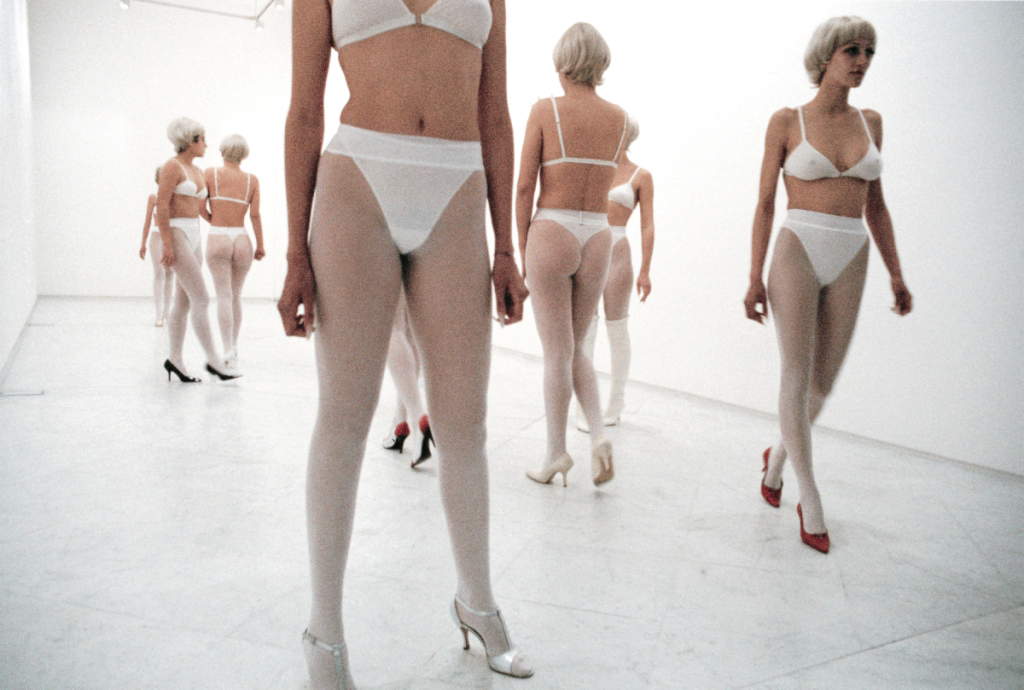
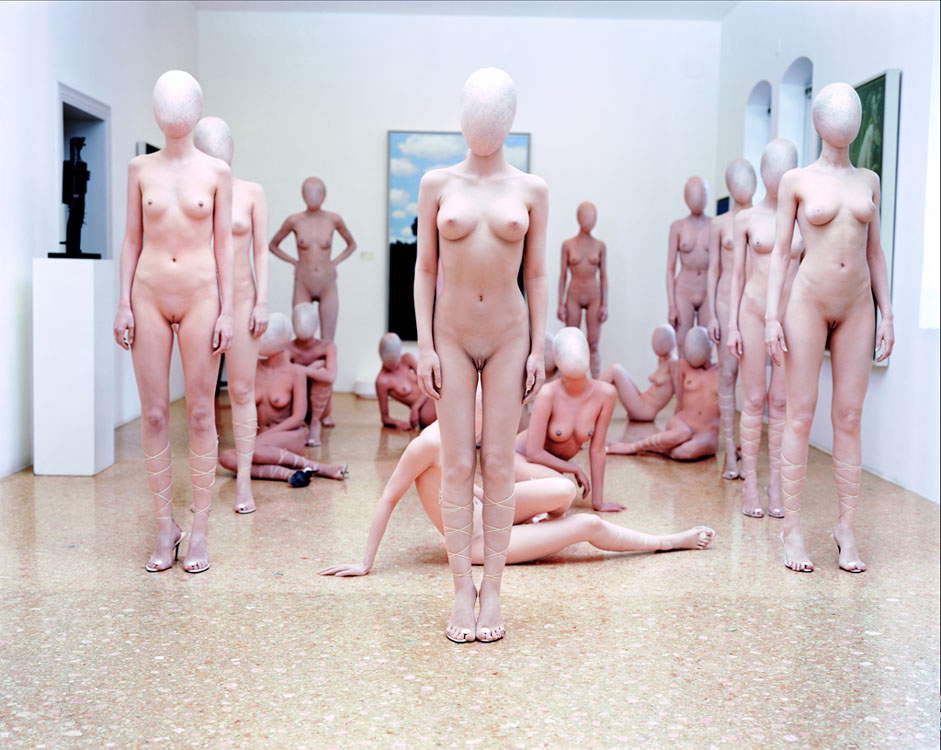
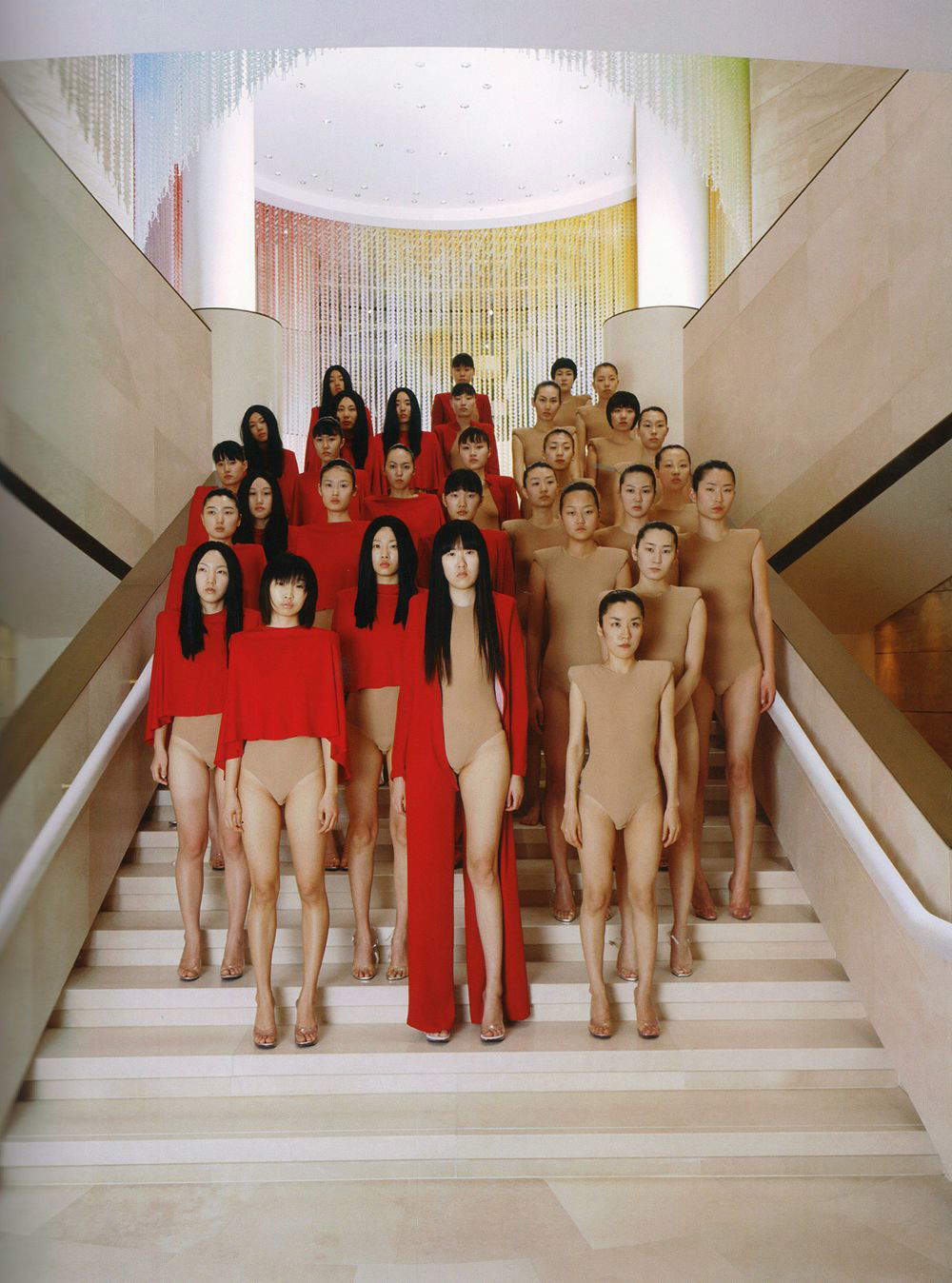
It was precisely in those 1990s that the fashion industry was consolidated and big brands entered as a subject as much in artistic operations as in the organization and promotion of art, contributing to that phenomenon of hybridization between the value of the unique piece and multiples, art collections and fashion collections. Limmaginario Beecroft will be disruptive, critical and criticized since her first exhibition in 1993, but after more than twenty-five years of influence she continues to respond to the conviction that in order to break free from patterns one must make use of them and overturn them.
Her New York gallerist of the early days, Jeffrey Deitch, writes that with her performative facility “she created a conceptual inversion, turning pattern into art [ ], the first to have transformed that intuition into an aesthetic system and articulated it into an unbroken body of work.” Indeed, she would prove to be very prolific, reiterating the same visual motif in what are to date about a hundred performances and which, titled with her initials VB and according to progressive numbering, are conceived as a single coherent discourse.
Starting alloriginally from drawing and with the support of photography, these are living paintings and subsequent reproductions. The material used for creation is human and exhibited in the presence of the audience, and the composition is inspired by and follows the rules of painting. Collective portraits of the idealized femininity of our consumerist society, based on the European painting tradition, particularly from the 15th century. Harmonious groups of figures that celebrate and actualize canonical female beauty, drawing on the centuries-old practice of drawing the nude. And as in the well-established language of tableaux vivants, the figuration is static and the models are posed to compose the surfaces of paintings or sculptures from life. “Art born from art, contaminated by genres and subgenres, oscillating relentlessly between academic normativity and pure entertainment,” as Flaminio Gualdoni theorizes. In Beecroft’s case the inspiration to aesthetic norms is diachronic, she frequents and uses sculpture, and her characters are characterized by ill-concealed quotations, from the classicism of ancient statuary to super contemporary mass-media icons, where laura and limperturbability are analogous.
Likewise, the nourishment of this visual quest is in the unavoidable references to her biographical events that find narrative and self-representation with the respectability of art.Multiple aspects are at stake that pertain to the eternal appearance of models toward lumana weakness, perfection versus fragility, then the relationship between nudity and clothing, freedom and constraint. Note that the nudity exhibited by Beecroft is but artificial and paralyzing, far from pure, conciliatory and naturalistic. The subjects like sculptures are placed on the pedestal, models that can be ordinary girls, professionals, dancers wearing shoes that as the case may be constitute an ideal base, as in monumental iconography. Borrowing from artistic training the practice with models posing from life and from fashion photography an icy artificiality, Beecroft uses bodies selected for homologous physical characteristics. Because that no form is ever superior to the other, at the turn of the century, does not seem to apply to everything. Aesthetics and society of those 1990s and early 2000s imposed a standard of ethereal, angular thinness, a type of femininity that emerged with the anorexic supermodels and that Beecroft also makes her own in the personal affair. The subjects manifest themselves as presences suspended between the time-honored diction of theater and liconicity of film and advertising.
 Vanessa Beecroft
Vanessa Beecroft
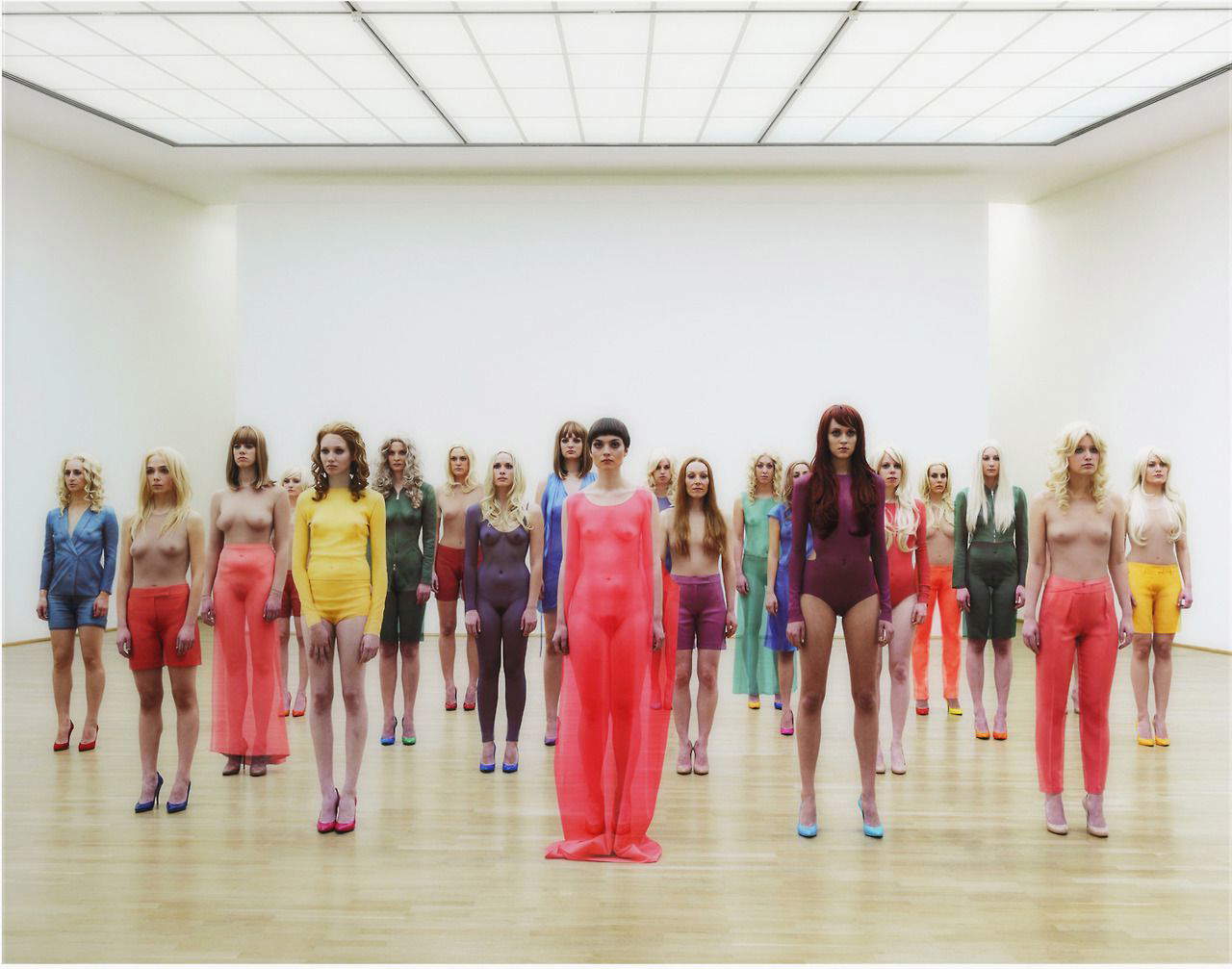

In the organization of the scene, the relationship between human and architectural geometries is constitutive (on the other hand, she graduated from Brera in stage design), and colors contribute to the effects in an essential way, even when the composition goes monochrome. The installations refer not only to the spaces, but also and precisely to the specificity of the places, returning with targeted projects suggestions on the contexts of exhibition, galleries, museums and spaces around the world. So that each performance is different from the previous one, documented in its relative uniqueness. It uses photography, the timelessness of the polaroid and the medium of video to ensure that performance events continue to have life, becoming independent works even beyond mere documentation. By offering viewpoints that even the audience present at theoccasion may not have perceived, the transitional value of the performance is emphasized. Shots and footage are significant of the culminating moments and thematic nodes of each, although the strength of its photo-videography lies in itsutonomy from the live performance.
In contrast to many school-leading performance actions, in providing for the breaking through of the museum limit of looking-not-touching and for which contact with the audience is principal, in VB there is no contact and a distance from the spectators is desired. The mannequin-bodies of the mise en scène are placed at the center of attention so that one first and foremost contemplates their beauty in an atmosphere of rarefaction, the forms can persuade though not exposed in the intent to seduce. As if to convey the muliebral, silent, melancholy enchantment of certain paintings, certain cinema and fashion images but in the postures of virile military squadrons.
And indeed, the models are made up and arranged with specific criteria that enhance a sensual pictorialism and formal balance; nothing but ironic, without apparent voluptuousness, they go to compose fragmented but unified images. Each body, depersonalized, belongs to a whole that is from time to time homogeneous, built either around the details of commonly erogenous accessories, such as underwear and stockings, shoes, laces and wigs of fetishistic appeal. Or where involved project partners, in haute couture dresses from the world’s leading brands, with whom the artist habitually collaborates. She has been one of the first to establish in these decades a kind of stable involvement with stylists, designers, musicians and celebrities.
In the reproductions as well as in the sculpture of her own making, Beecroft then identifies anatomical details and additional ways of observing the nude body from the whole. It is from 1996 that the work VB23 made at the Ludwig Museum in Cologne in which she begins to undress girls. In a confrontation with the overflowing supply of glossy pornography, structured by genre and preference but nevertheless around a cliché of rigid and obsessive bodily control, nudity must therefore be interpreted.
It is the faces of Beecroft’s woman-types that impose a reflection on the sphere of leros, its representations and inflections: they appear uniformly biblical, embodiments of the archetype of the saint, and on which, looking beyond the different physiognomies, visceral passions seem silenced. Her works are based on the value-threshold of prejudice. Lartista presents herself as a woman who looks at women’s bodies and makes unabashedly provocative use of nudity with an apparent erotic appeal, at the same time anti-erotic in that it is intimidating, considering the hyper-connotation of the attributes of a multiplied femininity. The value-threshold, precisely, is lambiguity: on the one hand an adhesion on the other a rejection of the stereotypes of the woman-object, of the predominant and conventional male power and thus of gender issues.
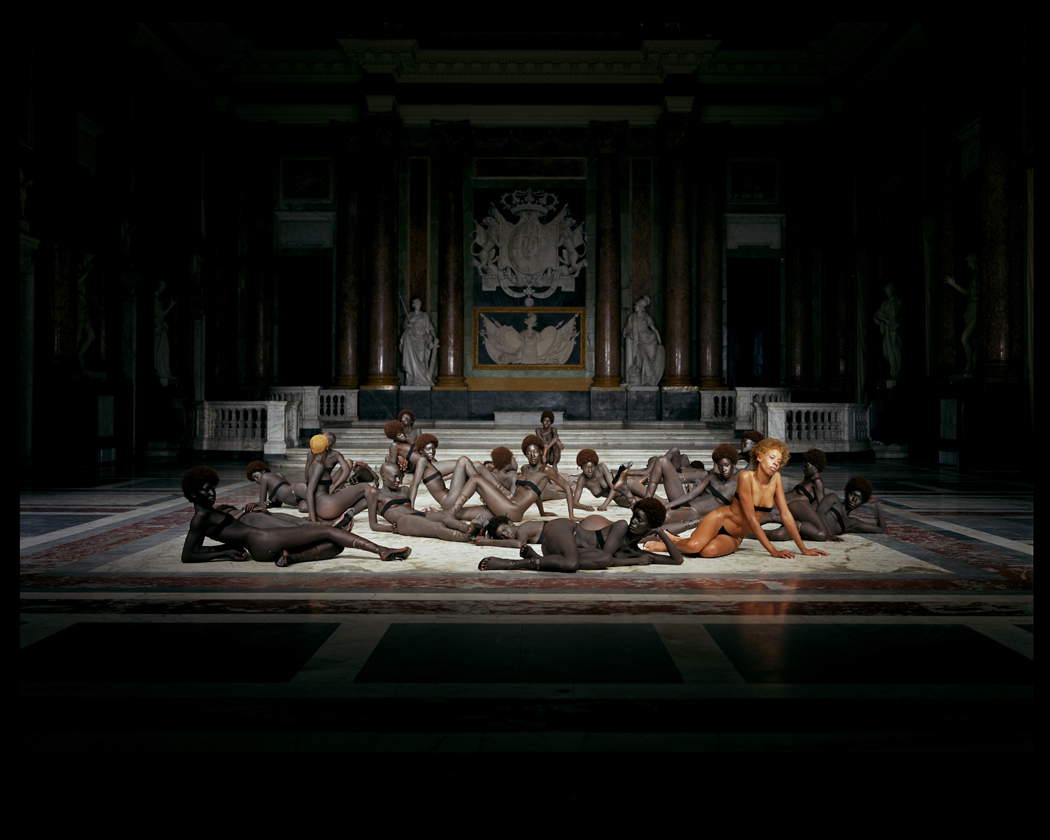
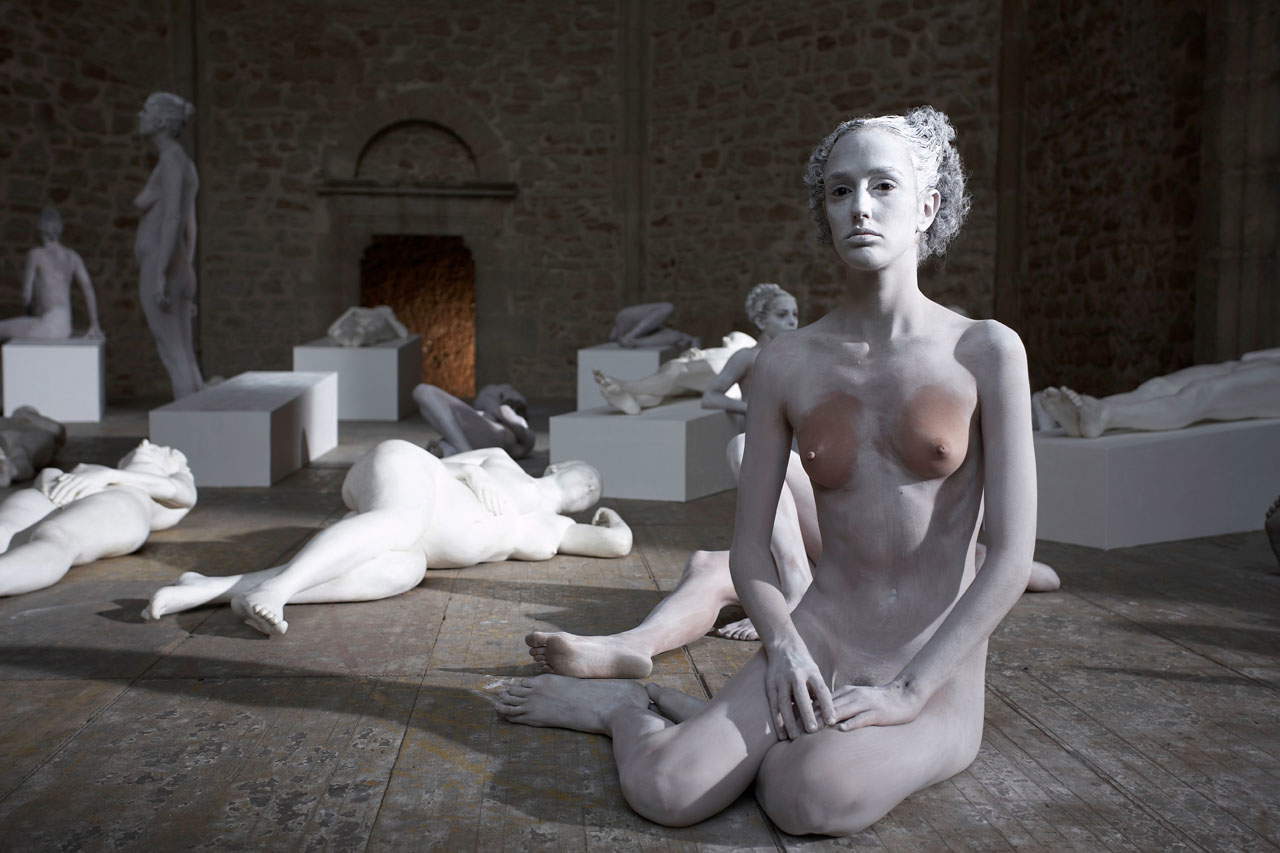


Expressly, from her research, “the models are given rules to follow until the end of the performance.” Thus she reports to Massimiliano Gioni in a recent 2017 interview, “the rules allow for movements and the breaking of the composition, but not dialogue or interaction with the audience or between the perfomers. They are told: don’t talk, don’t smile, don’t move theatrically, don’t move too slowly, be simple, be natural, be detached, don’t make eye contact, hold your position, don’t make the same movements at the same time as the others, alternate between a resting position and a position of attention, if you have to leave do it quietly, be focused, don’t look into the camera, hold on until the end of the performance, don’t take off your shoes, don’t be stiff, be tall, don’t be sexy, act as if no one is in the room, don’t break the rules, you are the essential element of the composition, your behavior influences that of the others, towards the end you can lie down, before the end stand up straight.”
In such an imaginative universe a boundary between public and private appears evident, lintimacy is never betrayed as a strict and serious officialdom is recognized public front. Yet lorchestration provides a moment from which onward the model becomes personalized in the reactions of each of the women portrayed and limmagine returns to the flesh because as the hours pass limmobility becomes tiring, one after the other they begin to move and the imposed rigidity goes out of place. What she calls the transition from a symbolic Donald Judd to a Jackson Pollock, in a succession from the figurative to the abstract.
p>The trace of the change of state will activate a typical voyeuristic mechanism, as well as a range of possible reactions, as many as the taboos and cultural approaches on different continents. Which is then the basis of Perfomance Art, subverting codified behaviors by calling out people’s response and amplifying the identity of places. Beecroft is a much-talked-about artist, her artistic nude is a tool that has sometimes been misunderstood, still dividing critics between those who assess her attitude as an adherence to dominant trends and those who pick up on her subliminal critical message.All the more so since the nude is at the service of controversial issues and nodal questions of the present, a tool in the same visual module to address the world’s scabrous mess: starting with prostitution, racial inequalities and limmigration, from the time when with VB48 he introduced black models at the G8 summit in Genoa in 2001. Returning to it again and again in special projects, even having twenty African immigrants perform in VB65, thus also approaching the male body (though clothed and carrying other meaning). In fact, he will deal with the value of theuniform in the military corps, forcing the limits of American institutionalism by employing soldiers and officers belonging to the U.S. Navy, and with wars, the ethnic one in Darfur, Sudan, making the most irrational of works in which he deals with the theme of motherhood and loss. To isolate a few.
Beecroft photographs events in social history using the filter of glamour, but the denunciation as well as the quotation is not direct. Moreover, she reports, “dramas can be sublimated by glamour to be offered to all [ ] the nature of Art is not to deal with them but to take inspiration from them.” As early as 1998, art critic Roberta Smith on the occasion of VB35 held at the Guggenheim in New York wrote: “Its art; its fashion. Its good; its bad. Its sexist; its not. Its Vanessa Beecrofts Performance Art,” as if to say of an overwhelming art personality who found immediate as well as lasting international success.
This contribution was originally published in No. 7 of our print magazine Finestre Sull’Arte on paper. Click here to subscribe.
Warning: the translation into English of the original Italian article was created using automatic tools. We undertake to review all articles, but we do not guarantee the total absence of inaccuracies in the translation due to the program. You can find the original by clicking on the ITA button. If you find any mistake,please contact us.